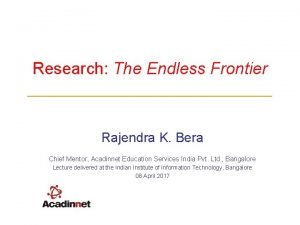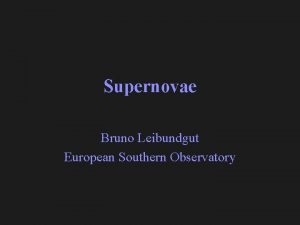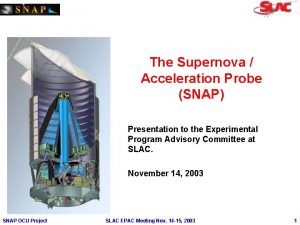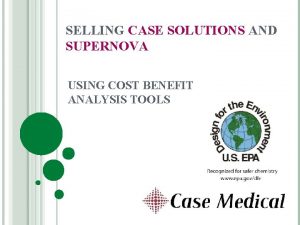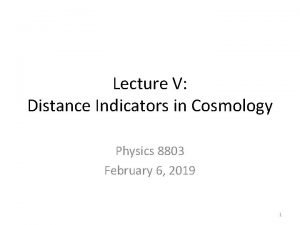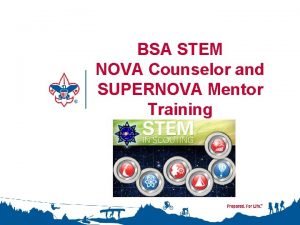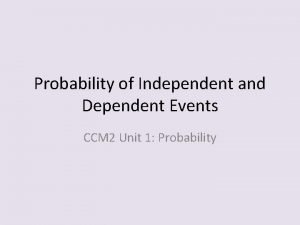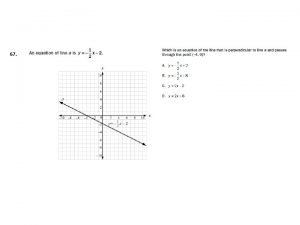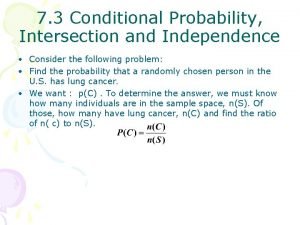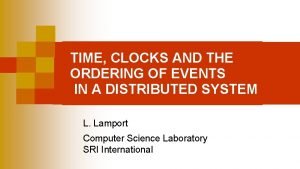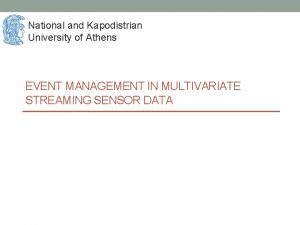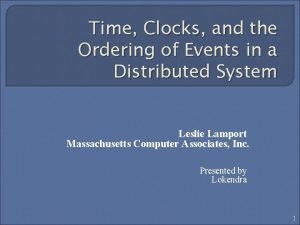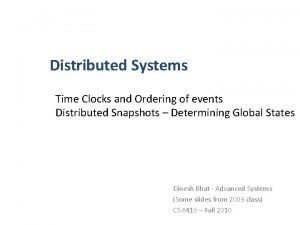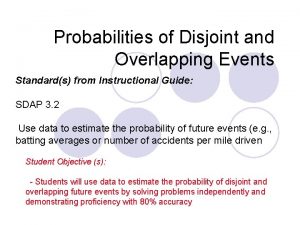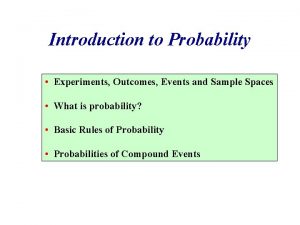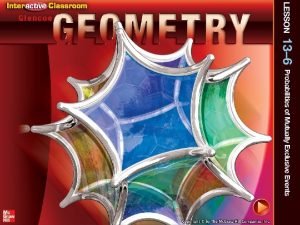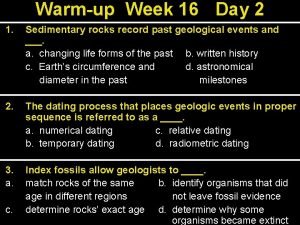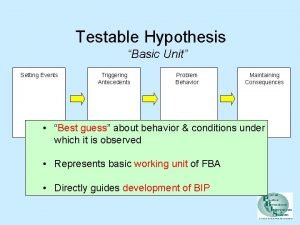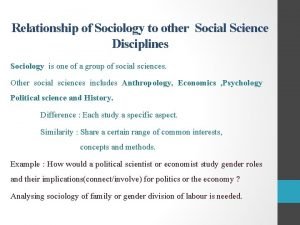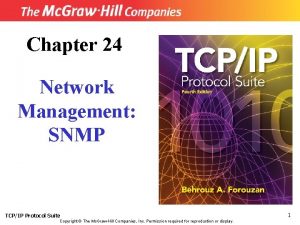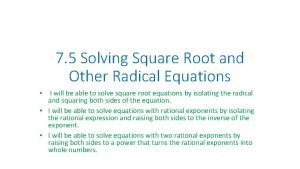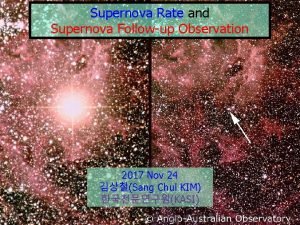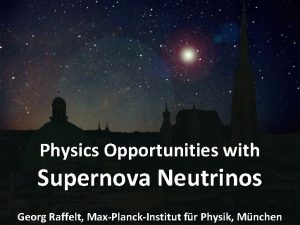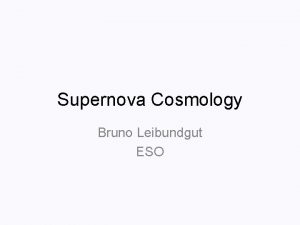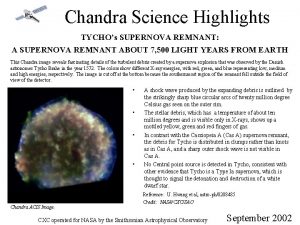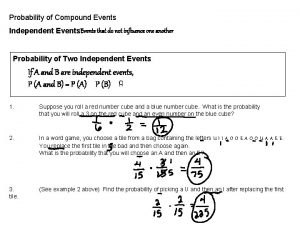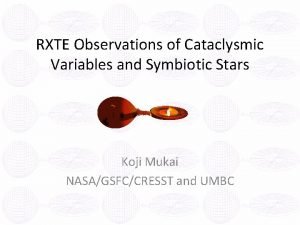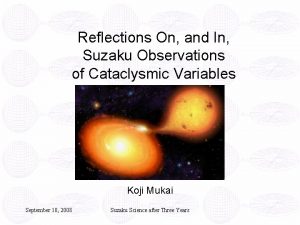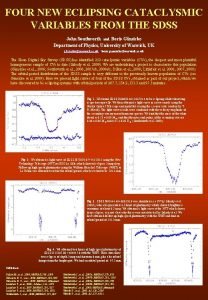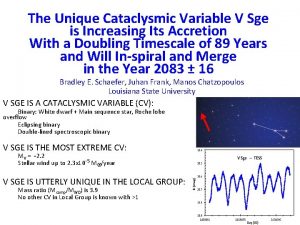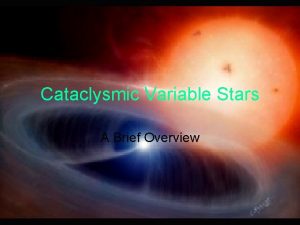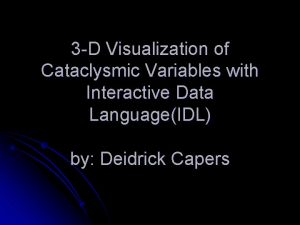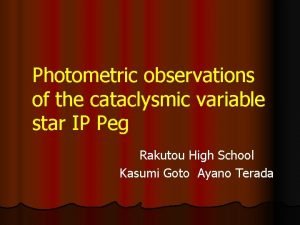Supernova Supernova And other Cataclysmic Events Introduction Whats



























































































- Slides: 91


Supernova! Supernova (And other Cataclysmic Events!)


Introduction • • • What’s in a name Historical Supernovae Types of Supernova Where do they go? Really wild Explosions Can I see a Supernova?

Nova • Nova - Latin for New Star Faint star that suddenly brightens • Supernova! A bright star that explodes Can be as bright as an entire galaxy • Hypernova Appears to be as bright as the rest of the Universe

Early Supernova Reports • Supernovae can be visible in daylight • Many Chinese reports of “Guest Stars” • Rock Drawings?

Chaco Canyon - SN 1054? ?

Milky Way Supernovae Year 185 AD 393/396 1006 1054 1181 1572 1604 1667? Date Apr 30 Jul 4 Nov 6 Oct 9 Con RA Dec mag Comment Cen Sco Lup Tau Cas Oph Cas 14: 43. 1 17: 14 15: 02. 8 05: 34. 5 02: 05. 6 00: 25. 3 17: 30. 6 23: 23. 4 -62: 28 -39. 8 -41: 57 +22: 01 +64: 49 +64: 09 -21: 29 +58: 50 -2 -3 -9 -6 -1 -4 -3 6? -6 mag M 1 Tycho Kepler Cas A SN

SN 1987 A Before After

Supernova Types • Type 1 • Type 2 • There are various subclasses • Defined by their Spectra and Lightcurves

The Spectrum

Types of Spectrum

Spectra of Elements Hydrogen Helium Carbon

Solar Spectrum

Type 1 Supernova

Type II Supernova

Lightcurve Comparison

Supernova Mechanisms • Basic Stellar Structure • Type II Supernovae • Type I Supernovae

What is a Star? • A sphere of gas in hydrostatic equilibrium


What is a Star? • A sphere of gas in hydrostatic equilibrium • Nuclear Fusion within the sphere



What is a Star? • • A sphere of gas in hydrostatic equilibrium Nuclear Fusion within the sphere Emits energy as radiation and particles Varies in size and brightness over its lifetime





Helium Burning



Timescales

But…! • Iron won’t “burn” and release energy • No energy from the core holding up the outer layers • The core collapses to about 10 Km diameter • Protons and electrons are squeezed together to form neutrons and releasing neutrinos • Neutrinos escape speeding up the collapse

… And. . . • Infalling material rebounds off the core • Shockwave travels outwards compressing and heating surrounding gas • Remainder of the star blasted out • Energy released is about the same as the Sun will generate in its entire life! • Supernova!! (Type II)




Type II Supernova

Type 1 Supernova

Type I Supernova Mechanism • Form in Binary Systems • Gas falls from a Red Giant onto a White Dwarf


Type I Supernova Mechanism • Form in Binary Systems • Gas falls from a Red Giant onto a White Dwarf • Gas forms on the surface of the White Dwarf


Type I Supernova Mechanism • Form in Binary Systems • Gas falls from a Red Giant onto a White Dwarf • Gas forms on the surface of the White Dwarf • Mass Exceeds stability limit (Chandarasekar Limit - 1. 4 Msun)

Type I Supernova Mechanism • • • Core collapses Carbon Core ignites explosively Supernova! Always happens at the same Mass Limit Gives out (nearly!) the same amount of energy • Can be used as a “Standard Candle”

Type I Sn Standard Candle • Allows us to measure distance to very remote galaxies • Remote Galaxies are a long way back in time • Allows us to measure changes in the rate of Cosmic expansion • Expansion is speeding up!!

While we’re here. . • “Classical Nova” mechanism is very similar to Type I Supernova • Gas accretes in a binary system • Layer of hydrogen forms around the white dwarf (about 1/100, 000 Msun) • Hydrogen ignites as a shell around the White Dwarf


While we’re here. . • “Classical Nova” mechanism is very similar to Type I Supernova • Gas accretes in a binary system • Layer of hydrogen forms around the white dwarf (about 1/100, 000 Msun) • Hydrogen ignites as a shell around the White Dwarf … and ejects the surrounding Hydrogen as a Planetary Nebula


What Happens Next? • Type II Supernova core forms a Neutron Star • Surrounding material ejected by the shockwave

Neutron Stars • Type II Supernova core forms a Neutron Star ~ 10 Km in diameter • Incredibly dense - 200, 000 tons / cc • Spins very fast and has a very powerful magnetic field

Conservation of Angular Momentum

Conservation of Magnetic Flux • The star’s magnetic field collapses • Magnetic field density increases to about 1012 Gauss • Magnetic poles may not be aligned with rotational poles • Produces the Pulsar Lighthouse Effect



Pulsar Radiation • Detailed mechanism not really understood • Probably caused by the intensely curved fields around the magnetic poles • Electrons in a curved magnetic field emit radiation • Highly directed in two beams

Pulsar Discovery • First detected in Cambridge in 1967 by Jocelyn Bell Burnell and Anthony Hewish • Initial discoveries were called LGM

Fast and Slow Pulsars • Periods can range from a few seconds to milliseconds • They slow down over time but are highly accurate over normal timescales • Binary Pulsar has been used to prove theory of Relativity • Pulsars were used on the Voyager plaque to pinpoint the Earth



Crab Pulsar

Crab Pulsar

Crab Pulsar

Nucleosynthesis • Lighter elements are created by fusion


Nucleosynthesis • Lighter elements are created by fusion • Heavy elements are created by nuclear reactions – s-process (Slow Neutron Capture) – r-process (Rapid Neutron Capture) – p-process (Proton Capture)

Where do we come from? • All elements heavier than Helium were created in previous generations of Supernovae

Where do we come from? • All elements heavier than Helium were created in previous generations of Supernovae • “We are Stardust”

Some Very Big Explosions • Stars below about 8 Msun won’t go Supernova, including our sun • Very massive stars will blow off gas during their lifetime


Some Very Big Explosions • Stars below about 8 Msun won’t go Supernova, including our sun • Very massive stars will blow off gas during their lifetime • Core of a star > 25 Msun is too massive to be held up by Neutron degeneracy and will collapse to a Black Hole about 20 Km wide

Gamma Ray Bursters • GRBs • Found by spy satellites and thought to be nuclear tests in space! • Originally thought to be Milky Way objects • Now identified with very intense explosions in external galaxies • Hypernova

Hypernovae • Energy flux if isotropic would be immense, about the same as the rest of the universe for a few seconds • Likely to be a directed beam effect like Pulsars • No-one is sure but there a number of theories

Collapse of Magnetic Star ~ 40 Msun • Very massive star with strong magnetic field collapses to a Black Hole

Collapse of Magnetic Star ~ 40 Msun

Collapse of Magnetic Star ~ 40 Msun • Very massive star with strong magnetic field collapses to a Black Hole • Matter ejected at near the speed of light • Matter is constrained by magnetic field into jets at the poles • Relativistic effects include beaming of energy in the direction of travel


Neutron Star Merge


Hypernovae • There do appear to be 2 classes of GRBs so both theories may be right • About 1 GRB detected per day but we only see those where the beam is directed at us • Frequency much higher in the early universe than now • A local GRB pointed at Earth would essentially cook that hemisphere!

Observing a Supernova • One in the Milky Way every 250 years • Last one in 1667, so we’re overdue one! • Sn 1987 A in the LMC (our nearest neighbour galaxy) • Can be observed in external galaxies • Hundreds have been discovered by amateurs


SN 2002 ap

SN 2002 cs




Stop Press!

Summary • • • There are various types of exploding stars Novae, Supernovae (types I & II), GRBs Large to huge amounts of energy released Produce all heavy elements They are observable with amateur equipment

Some Resources • • http: //skyandtelescope. com http: //www. supernovae. net http: //www. theastronomer. org http: //www-astronomy. mps. ohiostate. edu/~dhw/Intro/current. html#lectures • http: //www. pas. rochester. edu/~afrank/A 105 /index. html
 Cataclysmic
Cataclysmic Cataclysmic
Cataclysmic Bruno leibundgut
Bruno leibundgut Supernova acceleration probe
Supernova acceleration probe Supernova
Supernova Supernova spectra
Supernova spectra Supernova
Supernova Supernova mentor
Supernova mentor Written and other recorded events of people
Written and other recorded events of people Mutually exclusive vs non mutually exclusive
Mutually exclusive vs non mutually exclusive Other initiated self repair example
Other initiated self repair example Whats hot whats not
Whats hot whats not The other wes moore socratic seminar questions
The other wes moore socratic seminar questions Intro paragraph essay example
Intro paragraph essay example Body paragraph
Body paragraph Second punic war key events and results
Second punic war key events and results Wilt thou be gone it is not yet near day
Wilt thou be gone it is not yet near day Identify independent and dependent events
Identify independent and dependent events Simple event and compound event
Simple event and compound event Independent probability
Independent probability It looks for patterns recurring characteristic and events
It looks for patterns recurring characteristic and events 7-3 independent and dependent events answers
7-3 independent and dependent events answers Mutually exclusive events examples with solutions
Mutually exclusive events examples with solutions Disadvantages of gagne's instructional events
Disadvantages of gagne's instructional events Review exercise terms and events answer key
Review exercise terms and events answer key Cellular events of acute inflammation
Cellular events of acute inflammation Dependent events and conditional probability
Dependent events and conditional probability What is a disjoint event
What is a disjoint event Meaning of short story
Meaning of short story Time clocks and the ordering of events
Time clocks and the ordering of events Questions about the great gatsby chapter 3
Questions about the great gatsby chapter 3 Speech acts
Speech acts National and kapodistrian university of athens events
National and kapodistrian university of athens events Leslie lamport time clocks
Leslie lamport time clocks Safety at sports and recreational events act
Safety at sports and recreational events act Exclusive
Exclusive Elements of the setting
Elements of the setting Leslie lamport time clocks
Leslie lamport time clocks A union b formula
A union b formula 10-7 independent and dependent events
10-7 independent and dependent events What is a significant life event
What is a significant life event Overlapping events probability
Overlapping events probability Sample space and events
Sample space and events Intersection and union of events
Intersection and union of events Brainpop independent and dependent events answers
Brainpop independent and dependent events answers 13-5 probabilities of independent and dependent events
13-5 probabilities of independent and dependent events Describing people and events
Describing people and events Sedimentary rocks record past geological events and ____.
Sedimentary rocks record past geological events and ____. Setting events and antecedents
Setting events and antecedents Bipolar and other related disorders
Bipolar and other related disorders Bipolar and other related disorders
Bipolar and other related disorders Literary present
Literary present Solving square root and other radical equations quick check
Solving square root and other radical equations quick check Sociology as a social science
Sociology as a social science Respect people privacy
Respect people privacy Compare and contrast the vocal music of pakistan and israel
Compare and contrast the vocal music of pakistan and israel Internet etiquette or netiquette
Internet etiquette or netiquette Gazelle symbiotic relationship
Gazelle symbiotic relationship It is the complex interrelationship between
It is the complex interrelationship between How do currents and magnets exert forces on each other
How do currents and magnets exert forces on each other Drinking black coffee drivers ed
Drinking black coffee drivers ed Which type of plan shows the layout of the hvac system?
Which type of plan shows the layout of the hvac system? Process of removing food
Process of removing food Chapter 9 net present value and other investment criteria
Chapter 9 net present value and other investment criteria Chapter 31 schizophrenia and other psychoses
Chapter 31 schizophrenia and other psychoses Licensing franchising and other contractual strategies
Licensing franchising and other contractual strategies Free enterprise and other economic systems
Free enterprise and other economic systems Vitamins and their other names
Vitamins and their other names Solipsism and the problem of other minds
Solipsism and the problem of other minds How to solve square root equations
How to solve square root equations Taste and other tales summary
Taste and other tales summary Relationship between social work and political science
Relationship between social work and political science Resolution no 435
Resolution no 435 Chapter 9 net present value and other investment criteria
Chapter 9 net present value and other investment criteria Topic 6 quadrilaterals and other polygons answers
Topic 6 quadrilaterals and other polygons answers Snmp uses two other protocols -------- and --------
Snmp uses two other protocols -------- and -------- Lesson 5 solving square root and other radical equations
Lesson 5 solving square root and other radical equations Lightly drawn line to guide drawing other lines and shapes.
Lightly drawn line to guide drawing other lines and shapes. Louie his cousin and his other cousin
Louie his cousin and his other cousin Kind of intertextuality
Kind of intertextuality My family and other animals characters
My family and other animals characters Persuasive bandwagon
Persuasive bandwagon Chapter 15 alcohol other drugs and driving
Chapter 15 alcohol other drugs and driving Technology and other operational risks
Technology and other operational risks Options futures and other derivatives
Options futures and other derivatives Therefore encourage one another and build each other up
Therefore encourage one another and build each other up To be in present simple
To be in present simple Romeo and juliet predictions
Romeo and juliet predictions Floor plan maths literacy grade 12
Floor plan maths literacy grade 12 Maps and scales grade 12
Maps and scales grade 12 Maps plans and other representations of the physical world
Maps plans and other representations of the physical world Respect other people's time and bandwidth
Respect other people's time and bandwidth
